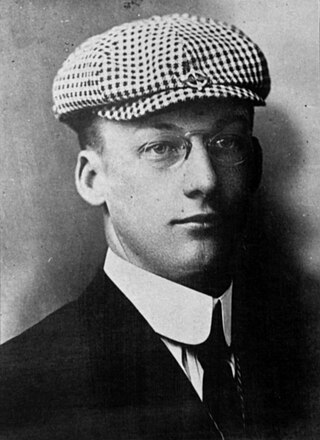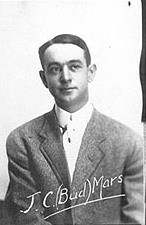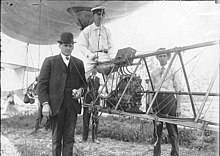
The Wright brothers, Orville Wright and Wilbur Wright, were American aviation pioneers generally credited with inventing, building, and flying the world's first successful airplane. They made the first controlled, sustained flight of an engine-powered, heavier-than-air aircraft with the Wright Flyer on December 17, 1903, four miles (6 km) south of Kitty Hawk, North Carolina, at what is now known as Kill Devil Hills. In 1904 the Wright brothers developed the Wright Flyer II, which made longer-duration flights including the first circle, followed in 1905 by the first truly practical fixed-wing aircraft, the Wright Flyer III.

Glenn Hammond Curtiss was an American aviation and motorcycling pioneer, and a founder of the U.S. aircraft industry. He began his career as a bicycle racer and builder before moving on to motorcycles. As early as 1904, he began to manufacture engines for airships. In 1908, Curtiss joined the Aerial Experiment Association, a pioneering research group, founded by Alexander Graham Bell at Beinn Bhreagh, Nova Scotia, to build flying machines.

A seaplane is a powered fixed-wing aircraft capable of taking off and landing (alighting) on water. Seaplanes are usually divided into two categories based on their technological characteristics: floatplanes and flying boats; the latter are generally far larger and can carry far more. Seaplanes that can also take off and land on airfields are in a subclass called amphibious aircraft, or amphibians. Seaplanes were sometimes called hydroplanes, but currently this term applies instead to motor-powered watercraft that use the technique of hydrodynamic lift to skim the surface of water when running at speed.
This is a list of aviation-related events from 1910:
This is a list of aviation-related events from 1911:

This is a list of aviation-related events from 1912:

Eugene Burton Ely was an American aviation pioneer, credited with the first shipboard aircraft takeoff and landing.

Didier Masson was a pioneering French aviator. He was born in Asnières, France. He died and was buried in Mérida, Yucatan, Mexico. Among his adventures was his life as a pioneering barnstormer, being the second flier in history to bomb a surface warship, as well as combat service in the Lafayette Escadrille with Edwin C. Parsons and Charles Nungesser. In one of the more unusual aerial victories of history, Masson shot down an enemy plane after his own plane's motor quit running. Later in life, he was a manager for pioneer Pan American World Airways, as well as a French consular officer.

Blanche Stuart Scott, also known as Betty Scott, was possibly the first American woman aviator. For her automobile journey across the United States she won the attention and admiration of pioneer aviator Glenn Curtiss who gave her flying lessons at the Curtiss flying school, in Hammondsport, New York, America's first flying school.

The Aero Club of America was a social club formed in 1905 by Charles Jasper Glidden and Augustus Post, among others, to promote aviation in America. It was the parent organization of numerous state chapters, the first being the Aero Club of New England. It thrived until 1923, when it transformed into the National Aeronautic Association, which still exists today. It issued the first pilot's licenses in the United States, and successful completion of its licensing process was required by the United States Army for its pilots until 1914. It sponsored numerous air shows and contests. Cortlandt Field Bishop was president in 1910. Starting in 1911, new president Robert J. Collier began presenting the Collier Trophy.

Lincoln Beachey was a pioneer American aviator and barnstormer. He became famous and wealthy from flying exhibitions, staging aerial stunts, helping invent aerobatics, and setting aviation records.

Thomas Scott Baldwin was a pioneer balloonist and U.S. Army major during World War I. He was the first American to descend from a balloon by parachute.

Charles Francis Walsh was an American pioneer aviator who died in a crash in Trenton, New Jersey.

Rockwell Field is a former United States Army Air Corps (USAAC) military airfield, located 1.1 miles northwest of the city of Coronado, California, on the northern part of the Coronado Peninsula across the bay from San Diego, California.

Major Harold Geiger was US military aviator number 6, who was killed in an airplane crash in 1927. He was also a balloonist. Spokane International Airport is designated with the International Air Transport Association airport code GEG in his memory.

The Curtiss No. 2, often known as the Reims Racer, was a racing aircraft built in the United States by Glenn Curtiss in 1909 to contest the Gordon Bennett Cup air race in Reims, France that year.

The Los Angeles International Air Meet was among the earliest airshows in the world and the first major airshow in the United States. It was held in Los Angeles County, California, at Dominguez Field, southwest of the Dominguez Rancho Adobe in present-day Rancho Dominguez, California. Spectator turnout numbered approximately 254,000 over 11 days of ticket sales. The Los Angeles Times called it "one of the greatest public events in the history of the West."

Charles Keeney Hamilton was an American pioneer aviator nicknamed the "crazy man of the air". He was, in the words of the U.S. Centennial of Flight Commission, "known for his dangerous dives, spectacular crashes, extensive reconstructive surgeries, and ever present cigarette" and was "frequently drunk". He survived more than 60 crashes.

Charles Foster Willard was an American aviator and engineer, who became known as the first barnstormer with his trick flights. Willard was the first person taught to fly by Glenn Curtiss in 1909 and was the 10th person to receive an official pilot's licence. Willard made a number of aviation 'firsts'.
Tod Corwin Shriver (1873-1911) was a U.S. aviator and exhibition pilot often associated with pioneer Glenn Curtiss. Shriver was a mechanic for Glenn Curtiss, much in the way Charlie Taylor was for The Wright Brothers, and accompanied him to France in 1909 to participate in the historic Rheims air meet officially Grande Semaine d'Aviation de la Champagne. In motion picture footage of Curtiss and his Reims Racer in France, Shriver can be seen joking with Curtiss and others. The footage is preserved in the National Air and Space Museum. Shriver began his association in aviation working with balloonist Thomas Scott Baldwin and in 1906 was working in Curtiss's Hammondsport factory. Shriver in 1910 became a pilot himself on the classic Curtiss pusher type. He also built his own machine in the summer and flew it the first time he tried. He was widely traveled in the final year of his life accompanying Thomas Scott Baldwin and James C. Mars to Hawaii, The Philippines, Australia, China and Japan. Later he made flights in South America. In Puerto Rico he made what was probably the first flight on the island but was the first pilot to die there when his machine fell 200 feet into a sugar cane field.



















